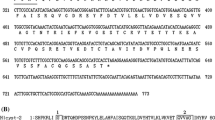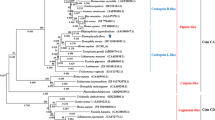Abstract
Ticks encounter various microbes while sucking blood from an infected host and carrying these pathogens in themselves. Ticks can then transmit these pathogens to vertebrate hosts. The immune system of ticks can be stimulated to produce many bioactive molecules during feeding and pathogen invasion. Antimicrobial peptides (AMPs) are key effector molecules of a tick’s immune response, as they can kill invading pathogenic microorganisms. In this study, we identified a novel cysteine-rich AMP, designated Rhamp1, in the salivary glands of unfed and fed female ticks (Rhipicephalus haemaphysaloides). Rhamp1 is encoded by a gene with an open reading frame of 333 bp, which in turn encodes a peptide of 12 kDa with a 22 amino acid residue signal peptide. The Rhamp1 protein had a pI of 8.6 and contained six conserved cysteine residues at the C-terminus. Rhamp1 shared 43 % amino acid identity with a secreted cysteine-rich protein of another tick species, Ixodes scapularis. We cloned the Rhamp1 gene and attempted to express a recombinant protein using prokaryotic and eukaryotic systems, to determine its biological significance. Recombinant Rhamp1 was successfully expressed in both systems, yielding a glutathione S-transferase (GST)-tagged protein (36 kDa) from the prokaryotic system, and a polyhistidine-tagged Rhamp1 protein (14 kDa) from the eukaryotic system. Rhamp1 inhibited the activities of chymotrypsin (16 %) and elastase (22 %) and exerted low hemolytic activity. It also inhibited the growth of Gram-negative bacteria, including Pseudomonas aeruginosa (49 %), Salmonella typhimurium (50 %), and Escherichia coli (52 %). Our findings suggest that Rhamp1 is a novel AMP in R. haemaphysaloides with the ability to inhibit proteinase activity.






Similar content being viewed by others
References
Armstrong PB (2001) The contribution of proteinase inhibitors to immune defense. Trends Immunol 22:47–52
Assenga SP, You M, Shy CH, Yamagishi J, Sakaguchi T, Zhou J, Kibe MK, Xuan X, Fujisaki K (2006) The use of a recombinant baculovirus expressing a chitinase from the hard tick Haemaphysalis longicornis and its potential application as a bioacaricide for tick control. Parasitol Res 98:111–118
Belmonte R, Cruz CE, Pires JR, Daffre S (2012) Purification and characterization of Hb 98-114: a novel hemoglobin-derived antimicrobial peptide from the midgut of Rhipicephalus (Boophilus) microplus. Peptides 37:120–127
Bignami GS (1993) A rapid and sensitive hemolysis neutralization assay for palytoxin. Toxicon 31:817–820
Brogden NK, Brogden KA (2011) Will new generations of modified antimicrobial peptides improve their potential as pharmaceuticals? Int J Antimicrob Agents 38:217–225
Bulet P, Hetru C, Dimarcq JL, Hoffmann D (1999) Antimicrobial peptides in insects; structure and function. Dev Comp Immunol 23:329–344
Chrudimská T, Slaninová J, Rudenko N, Růžek D, Grubhoffer L (2011) Functional characterization of two defensin isoforms of the hard tick Ixodes ricinus. Parasit Vectors 4:63
Chrudimská T, Čeřovský V, Slaninová J, Rego RO, Grubhoffer L (2014) Defensin from the ornate sheep tick Dermacentor marginatus and its effect on Lyme borreliosis spirochetes. Dev Comp Immunol 46:165–170
Esteves E, Fogaça AC, Maldonado R, Silva FD, Manso PP, Pelajo-Machado M, Valle D, Daffre S (2009) Antimicrobial activity in the tick Rhipicephalus (Boophilus) microplus eggs: Cellular localization and temporal expression of microplusin during oogenesis and embryogenesis. Dev Comp Immunol 33:913–919
Fogaça AC, Lorenzini DM, Kaku LM, Esteves E, Bulet P, Daffre S (2004) Cysteine-rich antimicrobial peptides of the cattle tick Boophilus microplus: isolation, structural characterization and tissue expression profile. Dev Comp Immunol 28:191–200
Fogaça AC, Almeida IC, Eberlin MN, Tanaka AS, Bulet P, Daffre S (2006) Ixodidin, a novel antimicrobial peptide from the hemocytes of the cattle tick Boophilus microplus with inhibitory activity against serine proteinases. Peptides 27:667–674
Galay RL, Maeda H, Aung KM, Umemiya-Shirafuji R, Xuan X, Igarashi I, Tsuji N, Tanaka T, Fujisaki K (2012) Anti-babesial activity of a potent peptide fragment derived from longicin of Haemaphysalis longicornis. Trop Anim Health Prod 44:343–348
Hajdušek O, Síma R, Ayllón N, Jalovecká M, Perner J, de la Fuente J, Kopáček P (2013) Interaction of the tick immune system with transmitted pathogens. Front Cell Infect Microbiol 3:26
Hynes WL, Ceraul SM, Todd SM, Seguin KC, Sonenshine DE (2005) A defensin-like gene expressed in the black-legged tick, Ixodes scapularis. Med Vet Entomol 19:339–344
Isogai E, Isogai H, Takahashi K, Kobayashi-Sakamoto M, Okumura K (2009) Antimicrobial activity of three tick defensins and four mammalian cathelicidin-derived synthetic peptides against Lyme disease spirochetes and bacteria isolated from the midgut. Exp Appl Acarol 49:221–228
Kato S, Ohtoko K, Ohtake H, Kimura T (2005) Vector-capping: a simple method for preparing a high-quality full-length cDNA library. DNA Res 28:53–62
Kopacek P, Hajdusek O, Buresova V (2012) Tick as a model for the study of a primitive complement system. Adv Exp Med Biol 710:83–93
Li J, Xu X, Xu C, Zhou W, Zhang K, Yu H, Zhang Y, Zheng Y, Rees HH, Lai R, Yang DWJ (2007) Anti-infection peptidomics of amphibian skin. Mol Cell Proteomics 6:882–994
Lieskovská J, Kopecký J (2012) Tick saliva suppresses IFN signalling in dendritic cells upon Borrelia afzelii infection. Parasite Immunol 34:32–39
Liu Z, Liu H, Liu X, Wu X (2008) Purification and cloning of a novel antimicrobial peptide from salivary glands of the hard tick, Ixodes sinensis. Comp Biochem Physiol B Biochem Mol Biol 149:557–561
Liu L, Dai J, Zhao YO, Narasimhan S, Yang Y, Zhang L, Fikrig E (2012) Ixodes scapularis JAK-STAT pathway regulates tick antimicrobial peptides, thereby controlling the agent of human granulocytic anaplasmosis. J Infect Dis 206:1233–1241
Loukas A, Bethony JM, Williamson AL, Goud GN, Mendez S, Zhan B, Hawdon JM, Elena Bottazzi M, Brindley PJ, Hotez PJ (2004) Vaccination of dogs with a recombinant cysteine protease from the intestine of canine hookworms diminishes the fecundity and growth of worms. J Infect Dis 189:1952–1961
Mans BJ, Andersen JF, Francischetti IM, Valenzuela JG, Schwan TG, Pham VM, Garfield MK, Hammer CH, Ribeiro JM (2008) Comparative sialomics between hard and soft ticks: implications for the evolution of blood-feeding behavior. Insect Biochem Mol Biol 38:42–58
Oldiges DP, Parizi LF, Zimmer KR, Lorenzini DM, Seixas A, Masuda A, Da Silva Vaz I Jr, Termignoni C (2012) A Rhipicephalus (Boophilus) microplus cathepsin with dual peptidase and antimicrobial activity. Int J Parasitol 42:635–645
Reddy KV, Yedery RD, Aranha C (2004) Antimicrobial peptides: premises and promises. Int J Antimicrob Agents 24:536–547
Saito Y, Konnai S, Yamada S, Imamura S, Nishikado H, Ito T, Onuma M, Ohashi K (2009) Identification and characterization of antimicrobial peptide, defensin, in the taiga tick, Ixodes persulcatus. Insect Mol Biol 18:531–539
Silva FD, Rossi DC, Martinez LR, Frases S, Fonseca FL, Campos CB, Rodrigues ML, Nosanchuk JD, Daffre S (2011) Effects of microplusin, a copper-chelating antimicrobial peptide, against Cryptococcus neoformans. FEMS Microbiol Lett 324:64–72
Steffen H, Rieg S, Wiedemann I, Kalbacher H, Deeg M, Sahl HG, Peschel A, Götz F, Garbe C, Schittek B (2006) Naturally processed dermcidin-derived peptides do not permeabilize bacterial membranes and kill microorganisms irrespective of their charge. Antimicrob Agents Chemother 50:2608–2620
Tanaka T, Maeda H, Matsuo T, Boldbattar D, Umemiya-Shirafuji R, Kume A, Suzuki H, Xuan X, Tsuji N, Fujisaki K (2012) Parasiticidal activity of Haemaphysalis longicornis longicin P4 peptide against Toxoplasma gondii. Peptides 34:242–250
Tirloni L, Reck J, Terra RM, Martins JR, Mulenga A, Sherman NE, Fox JW, Yates JR 3rd, Termignoni C, Pinto AF, Vaz Ida S Jr (2014) Proteomic analysis of cattle tick Rhipicephalus (Boophilus) microplus saliva: a comparison between partially and fully engorged females. PLoS One 9:e94831
Tonk M, Cabezas-Cruz A, Valdés JJ, Rego R, Chrudimská T, Strnad M, Íma R, Bell-Sakyi L, Franta ZK, Vilcinskas A, Grubhoffer L, Rahnamaeian M (2014a) Defensins from the tick Ixodes scapularis are effective against phytopathogenic fungi and the human bacterial pathogen Listeria grayi. Parasit Vectors 7:554
Tonk M, Cabezas-Cruz A, Valdés JJ, Rego RO, Rudenko N, Golovchenko M, Bell-Sakyi L, de la Fuente J, Grubhoffer L (2014b) Identification and partial characterisation of new members of the Ixodes ricinus defensin family. Gene 540:146–152
Tsuji N, Battsetseg B, Boldbaatar D, Miyoshi T, Xuan X, Jr Oliver JH, Fujisaki K (2007) Babesial vector tick defensin against Babesia sp. parasites. Infect Immun 75:3633–3640
Yang ST, Shin SY, Hahmb KS, Kim JI (2006) Design of perfectly symmetric Trp-rich peptides with potent and broad-spectrum antimicrobial activities. Int J Antimicrob Agents 27:325–330
Yount NY, Bayer AS, Xiong YQ, Yeaman MR (2006) Advances in antimicrobial peptide immunobiology. Biopolymers 84:435–458
Yu D, Sheng Z, Xu X, Li J, Yang H, Liu Z, Rees HH, Lai R (2006) A novel antimicrobial peptide from salivary glands of the hard tick, Ixodes sinensis. Peptides 27:31–35
Zasloff M (2002) Antimicrobial peptides of multicellular organisms. Nature 415:389–395
Zhang H, Lee EG, Liao M, Compaore MK, Zhang G, Kawase O, Fujisaki K, Sugimoto C, Nishikawa Y, Xuan X (2007) Identification of ribosomal phosphoprotein P0 of Neospora caninum as a potential common vaccine candidate for the control of both neosporosis and toxoplasmosis. Mol Biochem Parasitol 153:141–148
Zhang H, Nishikawa Y, Yamagishi J, Zhou J, Ikehara Y, Kojima N, Yokoyama N, Xuan X (2010) Neospora caninum: application of apical membrane antigen 1 encapsulated in the oligomannose-coated liposomes for reduction of offspring mortality from infection in BALB/c mice. Exp Parasitol 125:130–136
Zhang H, Zhang W, Wang X, Zhou Y, Wang N, Zhou J (2011) Identification of a cysteine-rich antimicrobial peptide from salivary glands of the tick Rhipicephalus haemaphysaloides. Peptides 32:441–446
Zheng H, Zhou L, Yang X, Wang D, Liu J (2012) Cloning and characterization of a male-specific defensin-like antimicrobial peptide from the tick Haemaphysalis longicornis. Dev Comp Immunol 37:207–211
Zhou J, Gong H, Zhou Y, Xuan X, Fujisaki K (2006a) Identification of a glycine-rich protein from the tick Rhipicephalus haemaphysaloides and evaluation of its vaccine potential against tick feeding. Parasitol Res 100:77–84
Zhou J, Liao M, Hatta T, Tanaka M, Xuan X, Fujisaki K (2006b) Identification of a follistatin-related protein from the tick Haemaphysalis longicornis and its effect on tick oviposition. Gene 372:191–198
Zhou J, Liao M, Ueda M, Gong H, Xuan X, Fujisaki K (2007) Sequence characterization and expression patterns of two defensin-like antimicrobial peptides from the tick Haemaphysalis longicornis. Peptides 28:1304–1310
Acknowledgments
This work was supported by the Special Fund for Health Research in the Public Interest (grant No. 201202019), and the Agricultural Science and Technology Innovation Program (ASTIP) of China.
Author information
Authors and Affiliations
Corresponding author
Additional information
Houshuang Zhang and Siqi Yang contributed equally to this work.
Rights and permissions
About this article
Cite this article
Zhang, H., Yang, S., Gong, H. et al. Functional analysis of a novel cysteine-rich antimicrobial peptide from the salivary glands of the tick Rhipicephalus haemaphysaloides . Parasitol Res 114, 3855–3863 (2015). https://doi.org/10.1007/s00436-015-4615-8
Received:
Accepted:
Published:
Issue Date:
DOI: https://doi.org/10.1007/s00436-015-4615-8




